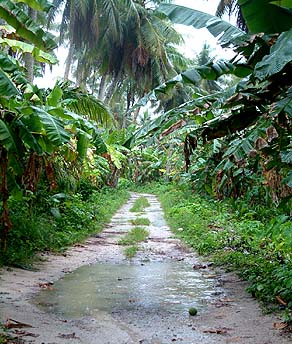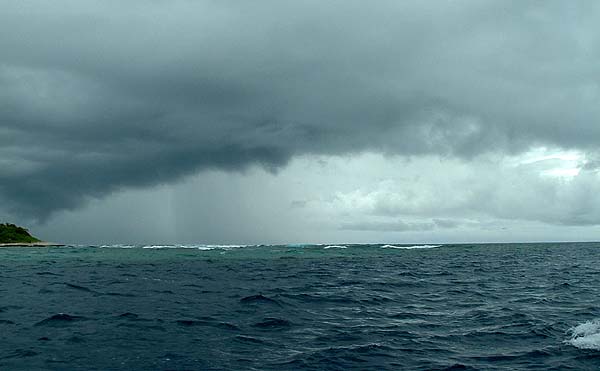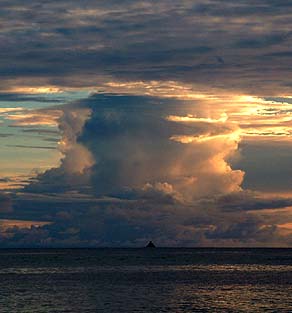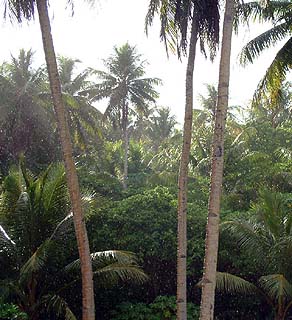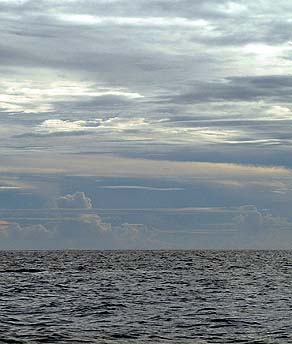 |
 |
 |
|||||
|
|
|
|
|
|
|
|
|
|
|
|||||||
|
|
|
|
Rain in Falalop.
|
|
“Clouds are observed in the East at dawn and also observed at dusk,” Steve says. “In Ulithi, if the color of the Western sky at sunset is sort of shiny, kind of silvery shiny, then you know there will be rain. If it’s seen at sunset, you know it’s going to come up at sunrise. "At times, when the sky turns like orange, you can say there will be some rain—some—but this silvery, shiny, you know it’s going to be a heavy rain. Depending on the distance of that silvery, shiny, if you know that it’s farther away, if you can see that it’s sort of farther away, you know the rain will come later on. If it seems like it’s really close, then you know it’s going to happen very soon."
|
||
|
|
||
“When during the day time, at noon, or afternoon, if you see clouds like rolling, not really rolling, breaking like the breakers of the waves, you know it’s going to be a storm. It’s not the ripple kind, it’s like the breaking of the waves, the breakers. "We usually start receiving rain in March, calmer weather. The name of that rain has to do with the star. Taepi is the name of the star and we say Faaeltaepi, ‘under Taepi.’ That’s about March. The Eastern star, usually there’s no rain under that one. “We get rain in the summer season. In the Fall season we get rain and wind. We usually have heavy rain in the summers. The wind’s not that strong. In the Fall we have the wind blowing away the clouds quickly. But when we do receive rain in the Fall, it’s with the wind."
|
Rain makes a puddle on a Falalop road.
|
|
“There are four type of rains,” Stanley says. “The first, it’s just drop; the second one is drop and go; and then one is like rain, constant rain, it’s plenty rain; and then there’s one that is, it’s just unbelievable. It’s just heavy downpour.” “When it just kind of sprinkles down, we call it, haromwromw. When it rains on and off, comes and go, we call it kkooachiiuch. It’s still raining, but it doesn’t last. When it rains hard, we call it ssongraaeg. "And when it’s rain so heavy, you would say in English ‘cats and dogs,’ we say yiudiul Sarbol. Yiiud means rain, Sarbol is the name of a star. In November that’s Sarbol, that’s the star that gives lots of rain. They named that type of rain after the star, the ‘rain of Sarbol.’ "Probably the month of that star gives so much of rain. So that star associated specifically with that condition. “When it’s like that, Mariano adds, “it is also expressed as ‘pouring water out of a container.’ It’s so heavy.” “Yes,” Stanley agrees, "t’s not a dropping, it’s like waterfall!
|
|
|
|
|
“There are rains that happen unexpectedly," Stanley continues. "Sometimes we just get the feeling of the heat, and that’s another indication of rain. We feel so much heat, so we believe that we will expect rain soon. I don’t know why it’s happened, but it’s happened. “And sometime when you see the moon at night, with a ring around, it’s also sign of rain. Sometime it take few days, or sometimes it’s not even a rain, it’s sun, it’s hot, sunny day, but most probably it’s going to rain. That’s when you see the moon at night with a big ring around. I don’t know why."
|
||
|
|
||
"In my family, my grandfather—my mother’s father—was very good in predicting the weather," Mariano recalls. "He could read it up to one month ahead. At that time I was too young to learn anything before he passed away. So what I know about clouds is that, if it’s lifting up like that opening up from the horizon they know it’s going to pass. But if it’s solidly like over the horizon, they know it, it may come our way. "And also depending on the wind direction. Whether to blow it our way or blow it your way. At sundown you can see the color of the clouds in the twilight. If it’s a reddish, you know there might be rain next day. "Navigators are really good in observing the clouds. Early each
morning, before sun up, he would be looking up in the east watching
all the horizon clouds and sky, then they’ll know what’s
going to happen in a few days."
|
|
|
“Some old villagers say that if it’s a sunny day and it’s sprinkling, is considered bad luck. Probably a prediction somebody’s going to die. Also, a rainbow at night. If it’s not the flu coming, or a certain epidemic, break out. These are old beliefs. In my younger days, I used to believe that about the sickness rain .If it rains with the sun shining, there will be a death or we’ll get the flu.” “On Ifalik we have a belief that when it rains while the sun is shining, we’ll receive fish,” Steve says. “It means a huge school of fish, mainly tuna, will come into the lagoon and get stuck in the lagoon. "That’s what he heard from the old people, because if you pass a lagoon with an opening, that’s it’s set in a way that once the tuna entered the lagoon it can not find it’s way out. So it just goes around circling inside of the lagoon."
|
|
|
|
“Rain that comes on and off, that’s what they believe, maybe something will happen. If there are pregnant people, maybe their time to deliver is getting near. That’s the on-and-off rain. On-and-off rain is called hochowettaeng. ‘Cry rain.’ It can also lead to the death of somebody. I guess that’s why it’s called a ‘cry rain’.
|
||
|
|
||
“In Ulithi—I don’t know, maybe older people used this to scare children," Mariano considers, "but when I was young, I still remember that, when there is a rainbow, you watch the rainbow. If it’s moving toward your island, then you better run and hide in the house. It is believed that once the rainbow steps down on a place, it burns the place. You don’t want to get burned, so you have to run in the house and hide. I used to run away from that rainbow, I didn’t know that there’s a pot of gold at the end of that rainbow. “Older people used the rainbow to show them direction,” Steve says. “Some magic has to be applied for the rainbow to appear; where that rainbow appears, there should be an island, providing that the magic is applied appropriately, or properly. It will show you the island you are looking for.
|
|
|
“Many have to learn that there’s magic, because once we’re getting confused out on the open sea, and if we don’t know the magic, there would be no rainbow to appear. Then you cannot find the island you’re going to. "Once you become a navigator, you should have learned almost everything in regards to travel, weather, and magic. We have no instruments to travel by, to guide us, so you have to memorize everything. "That’s why when you return from a voyage, you the navigator, you have to stay put. You don’t go walk around, sneaking around the island, because this will distract your mind when you go back again on the open sea."
|
|
|
|
“There are no Ulithian navigators anymore,” Stanley remarks. “The last navigator just died and we cannot sail, but if you become a navigator you have to know all the seasons, you have to know all the stars, when it’s going to be stormy, so that you can know your way, when you should go and when you should not.”
Next we look to the results of the rain on the land: the forest.
|
||
|
|
||
|
|
|
|
|
|

|
| Ulithi Home | Map Library | Site Map | Pacific Worlds Home |
|
|
|
|

|
|
|
||
|
Copyright 2003 Pacific Worlds & Associates • Usage Policy • Webmaster |

